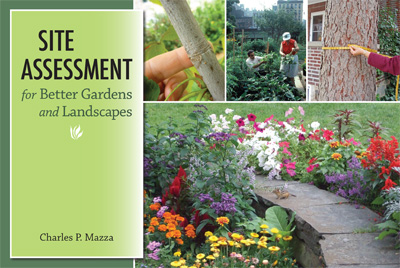Site Assessment for better gardens and landscapes

Quick links to additional resources.
Site assessment - the "discovery process" that reveals the characteristics that make your yard unique - can help your gardens and landscapes thrive.
In the step-by-step process, the hands-on activities in this workbook help you find out about compaction, drainage, existing plants, hardiness, light, microclimates, obstructions, slopes, soil, space dimensions, wildlife interference, and wind interference - all of which can influence the success or failure of your plantings.
Matching your plantings to your site's characteristics will help you create more-sustainable and easier-to-care-for gardens and landscapes.
This page provides quick access to websites mentioned in the hard copy publication. Find ordering information for the book on the Plant and Life Sciences Publishing website.
General Planning Information
Botanical Gardens, Public Gardens, and Arboretum Locations:
Cooperative Extension Office Locations:
Home and Garden Information Center:
- http://www.hgic.umd.edu/
Horticultural information to the public nationwide through a diagnostic website. Sponsored by the University of Maryland Cooperative Extension.
Information about Heavy Metals:
Step 1 - Garden and Landscape Area
- Wasp and Bee Management: A Common-Sense Approach, Jody Gangloff-Kaufmann, NRAES, Ithaca, NY, 2011. Available from Plant and Life Sciences Publishing, palspublishing.cals.cornell. edu
Step 2 - Obstructions Above and Below
Dig-Safe System
Dwarf and Semi-dwarf Fruit Trees
Small Trees (less than 30')
Step 3 - Sun and Shade
Step 4 - Hardiness and Microclimates
Frost
Microclimates
USDA Plant Hardiness Zone Map
- http://planthardiness.ars.usda.gov/PHZMWeb/
Hardiness zone designations for all parts of the United States. Detailed information for an area can be found by entering a zip code on the upper left of the web page or by using the interactive map. From the United States Department of Agriculture.
Step 5 - Wind
Windbreaks
Step 6 - Compaction
Dealing with Soil Compaction
Improve Your Soil with Cover Crops
Using Organic Matter in the Garden
Step 7 - Drainage
Drought Tolerant Plants
Rain Gardens
- http://learningstore.uwex.edu/pdf/GWQ037.pdf
Detailed homeowner instructions on creating a rain garden from the University of Wisconsin. Developed by Roger Bannerman, Wisconsin Department of Natural Resources and Ellen Considine, U.S. Geological Survey.
Soil Drainage
Soil Moisture Chart for Trees and Shrubs
Step 8 - Soil Characteristics
Books:
- Building Soils for Better Crops, 3rd Edition, Fred Magdoff and Harold van Es. Sustainable Agriculture Publications, Waldorf, Md. 2010. Hard copy available to purchase online at www.sare.org/publications/soils.htm.
- Composting to Reduce the Waste Stream, Robert Kozlowski, Plant and Life Sciences Publishing, 1991. Available to purchase online at www.palspublishing.cals.cornell.edu
Organic Matter
Salt-tolerant Trees
Salt Sensitive Trees
Soil Basics
Soil Health
- http://soilhealth.cals.cornell.edu
Cornell Soil Health website. Includes a soil health assessment manual - primarily for farmers, but instructive to others. From Cornell University.
- http://www.soilhealth.com/
Includes a section that explains how soils are alive. From the University of Western Australia.
Step 9 - Slopes
Building Retaining Walls
Deciduous Woody Ground Covers
Herbaceous Ground Covers
Step 10 - Wildlife Interference
Moles
Wildlife Damage Management and Control
Step 11 - Existing Plants
For Further Reading.
Books
- Broadleaved Shrubs and Shade Trees: Problems, Picture Clues, and Management Options, NRAES-183, by Mary Kay Malonoski and David Clement, NRAES, Ithaca, NY. Purchase online at www.palspublishing.cals.cornell.edu
- Tree ID Guide for Common Urban Trees in New York State and the Northeast. Urban Horiculture Institute, Cornell University. Order form available for this pocket-sized book at: http://www.hort.cornell.edu/uhi/outreach/index.htm
Herbaceous Perennials
Tree Identification
Step 12 - Putting It All Together
Checklist for Site Assessment
References and Resources
General Advice
Botanical Gardens, Public Gardens, and Arboretum Locations
Cooperative Extension Office Locations
Home and Garden Information Center
- http://www.hgic.umd.edu/
Horticultural information for the public nationwide through a diagnostic website. By the University of Maryland Cooperative Extension.
Landscape Design
Land grant university Cooperative Extension programs provide resources that can help you adapt this workbook to your region. Consult your state's Cooperative Extension service and/or county office for specific local information. Here are a few:
Plant Selection
These references include a few that are mentioned earlier in the workbook.
- Improve Your Soil with Cover Crops, Ecogardening Factsheet #9 http://blogs.cornell.edu/horticulture/about/basic-gardening-info/cover-crops/ From Cornell Garden Based Learning, the Department of Horticulture, Cornell University.
- Plant Database of Trees, Shrubs and Vines, University of Connecticut. Trees, shrubs, and vines are listed by common and scientific name along with plant attributes. http://www.hort.uconn.edu/plants/
- Recommended Urban Trees: Site Assessment and Tree Selection for Stress Tolerance, Urban Horticulture Institute, Cornell University, 2009. Available online in PDF format at: http://www.hort.cornell.edu/uhi/outreach/recurbtree/ This site also includes an order form for a 133-page paper copy.
- Tree ID Guide for Common Urban Trees in New York State and the Northeast. From the Urban Horticulture Institute, Department of Horticulture, at Cornell University. Order form available for this pocket-sized book at: http://www.hort.cornell.edu/uhi/outreach/index.htm
Growing Vegetables and Fruits
- Cornell Gardening Resources - Vegetables, Cornell University http://blogs.cornell.edu/horticulture/vegetables/ The Cornell site has a vegetable selection feature, while most other sources only tell you how to grow a particular vegetable. Consult your local Cooperative Extension for vegetable gardening information suitable for your region.
- Cornell Guide to Growing Fruit at Home, Department of Horticulture, Cornell University, 2003. Includes sections on tree fruits, grapes, strawberries, brambles, blueberries, and more. http://www.gardening.cornell.edu/fruit/homefruit.html
- Home Vegetable Gardening, by Larry Bass, North Carolina State University
http://www.ces.ncsu.edu/depts/hort/hil/ag-06.html
|
